Sansevieria (also known as Mother-in-Law Tongue or Snake Plant) is an amazing plant. The sansevieria originally came from Africa and made its way to Europe in the 18th century.
The scientific name for this particular sansevieria is Dracaena Trifasciata. Its sword-like leaves have striking sculptural beauty and the care is very simple. I have snake plants in nearly every room of my home and they bring lots of visual interest to the environment!
Related: Love plants? Learn how to care for Jade Plants, Peace Lilies, Fiddle Leaf Figs, Calathea, Pilea, Monstera Plants, Spider Plants, Christmas Cactus, Poinsettia, Dieffenbachia, Money Trees, Hoya Plants, and String of Pearls like a pro!
Table of Contents
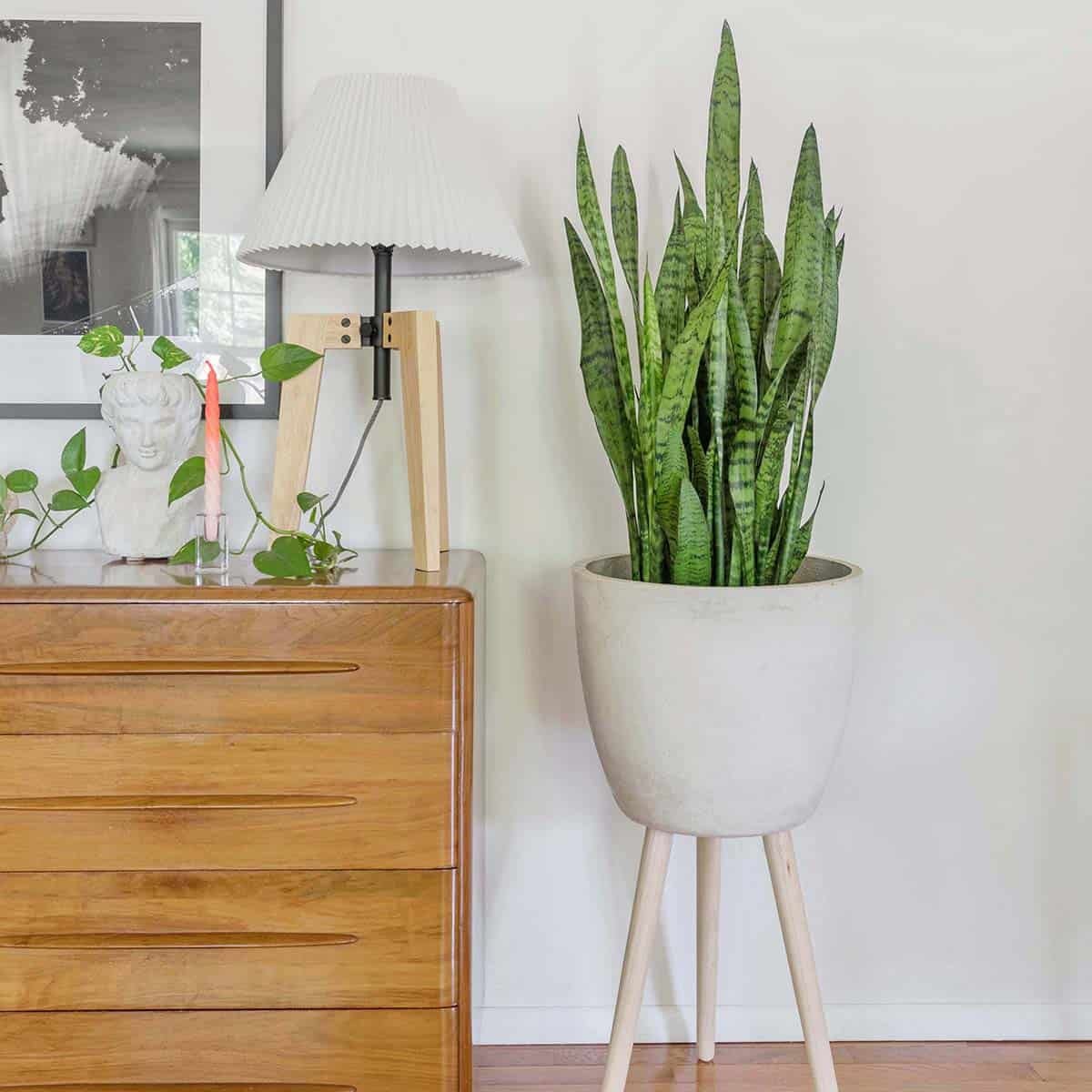
There have been studies that show the sansevieria removes harmful chemicals from the environment and releases oxygen, resulting in it having air purifying qualities. The jury is still out on how effective it is in purifying the air, but I still have one in almost every room 🙂
This special plant is a great starter houseplant green-thumb beginners as it can tolerate drought and low-light situations and with its easy care, you can’t go wrong with it! In this post, I wanted to share some tips on caring for your sansevieria.
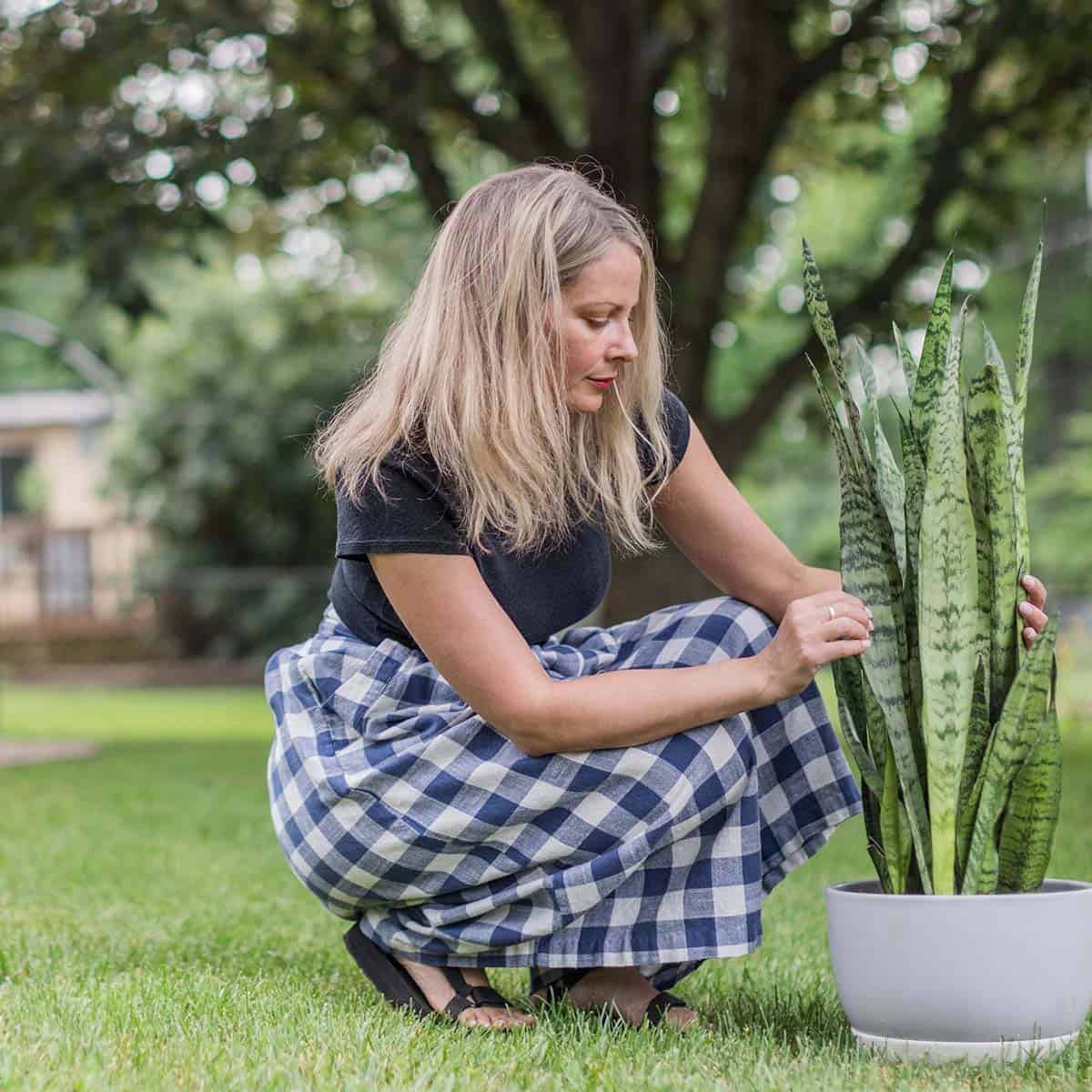
Potting
When you get a sansevieria from the garden store or maybe a friend shared part of theirs, you need to know the best repotting tips so your so your new plant can thrive. First, snake plants LOVE well draining soil. Avoid compact soil because this kind of soil will hold more moisture and could lead to root rot.
Root rot is when the soil gets waterlogged. If the plant stays wet for too long, the roots can rot and eventually, your plant will die. This is the quickest way to kill a sansevieria.
These plants are very similar to cacti when it comes to their care. They don’t like to be sitting in water for too long. One of the main things that will keep your plant from root rot is well draining soil.
You can buy a premade cactus/succulent soil (it’s a mix of sand and soil) and most garden stores will carry it. Having the sand in the soil will keep the soil aerated and let the water run through the soil.
Adding a scoop of Perlite is a wonderful addition if you’d like to maximize the soil’s aeration. Perlite is naturally derived and comes from volcanic eruptions. If you add your own sand to your soil mix, make sure it’s made specifically for gardeners and growers.
Other sands (like play sand) are actually more compact and not the best for drainage in your plants. It may go without saying, but never use soil that has been outside. This will make your plant susceptible to pests or other organisms found outdoors.
I did this once and learned my lesson very quickly and brought in extra little critters that were harmful to my plant.
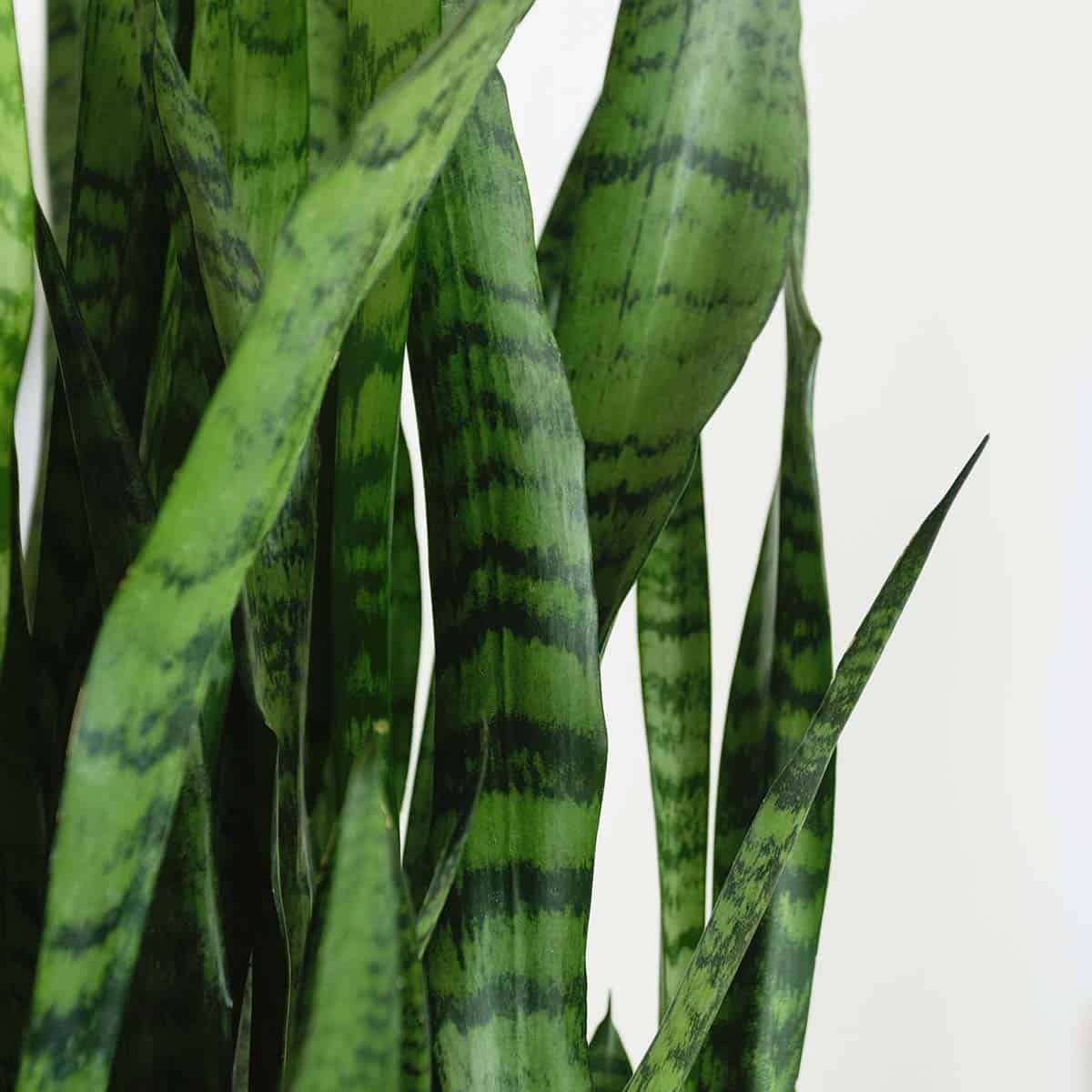
For pots, I love terracotta pots. These are the reddish clay ones that you can find almost anywhere. The terracotta allows the dirt to “breathe” so the moisture isn’t trapped inside. Terra cotta pots help with avoiding root rot as well.
The plant will dry out much faster in a terracotta pot because the clay wick’s water is from the soil. I have some plants in decorative earthenware pots that are not terracotta as well, but they all have a drainage hole at the bottom.
Make sure all pots have a drainage hole so the water has a way of escaping! Sitting water at the bottom of your pot will likely lead to death by root rot. Sometimes, I will find a gorgeous clay pot but there is no hole on the bottom!
This is easily fixed by drilling a hole using a specific drill bit. A quick YouTube video will teach you what you need to know if you’ve never drilled a hole in a pot.
Fertilizing
Your snake plant won’t need a lot of fertilization, but you can mix up a general plant fertilizer at half-strength and feed it at the beginning of spring the beginning of the growing season) and again in the middle of summer for a nutrient boost.
Repotting
I repot my sansevieria only when they need a little more wriggle room or when I purchase a new plant and need to take it out of the plastic pot it came in. You can tell if the plant is starting to be root-bound if you see roots starting to crawl out the holes in the bottom of the pot.
I like to get a pot that gives my new plant about 2 inches of growth room around the whole diameter of the pot. This gives the plant room to grow but it’s still a bit snug. Replanting your sansevieria in too big of a pot means more soil, leading to more time to dry out, which can lead to root rot.
Quick tip: The downside to using a terracotta pot is that because the pot lets the moisture breathe, the moisture will likely end up on the surface that your pot is on.
If you have a pot on a wood floor or wood surface, it’s a good choice to place a plate or nonporous material under the pot as that’s the easiest way to protect the pot from ruining your surface.
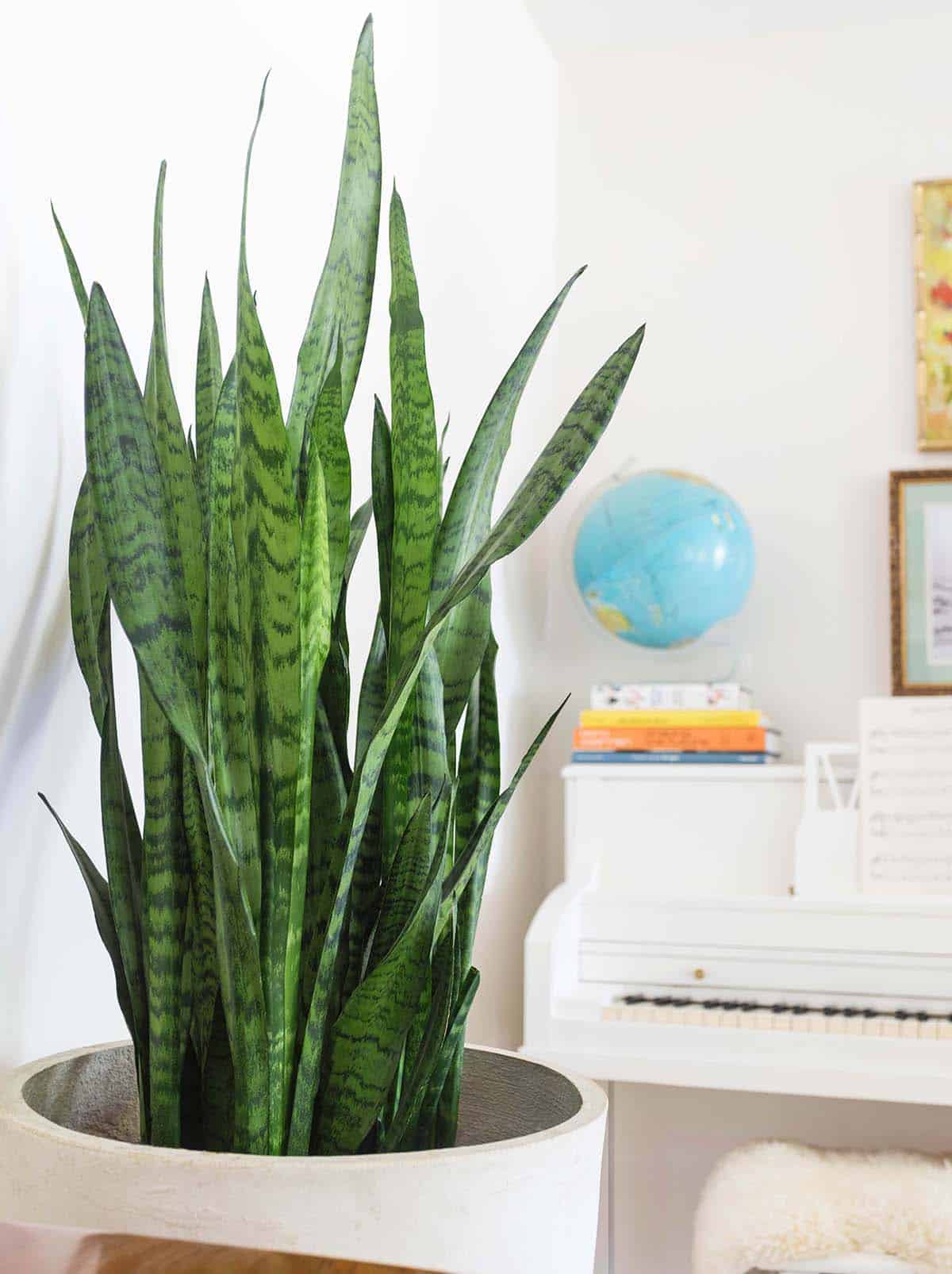
How Much Light Does a Snake Plant Need?
The wonderful thing about sansevieria is that it can handle diverse lighting situations. The plant will grow better in bright light (indirect light near a window in your home), but it can handle a darker corner in your home with less light exposure as well.
Low light is OK for the plant and it will be just fine in a room with low light. At my son’s school, there is an absolutely beautiful sansevieria in a room with no windows! The only light source is fluorescent light bulbs that are turned on during the day.
It’s amazing to see this plant thrive in what appears to be poor lighting conditions. It truly is an incredibly adaptable plant! I have sansiervieras all over my home and each one is in a different lighting situation. The ones near the windows will definitely grow faster, but the ones in low light are still happy (just a little smaller).
A rule of thumb when it comes to lighting: Just because they can live in some shade doesn’t mean that they will necessarily thrive in low light. They will definitely grow better in bright light.
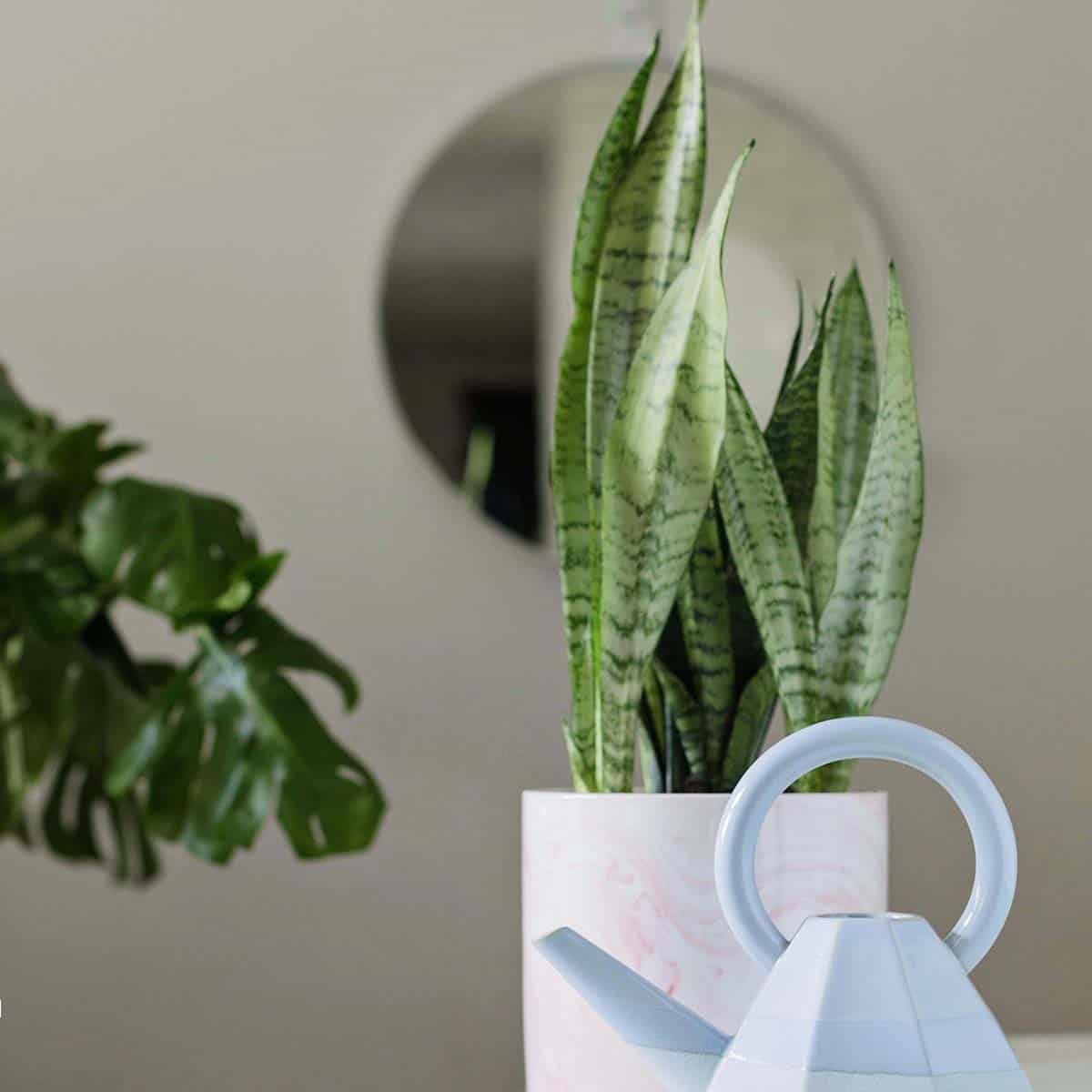
Watering
I find the more I forget about my snake plant, the better! Only water when the soil is dry. I like to stick my finger in about 3-4 inches to check if the plant’s soil is completely dry. If there is a little moisture in the soil, then I will check it again in a week.
How your plant holds moisture will depend on where you live. If you live in a dryer climate, then it will dry out faster, or if you live in a humid climate, then it will hold water longer. One tip that I have found to be vital is that I do not water my succulents or plants that like to dry out on rainy days.
Watering on rainy days keeps my plants soggy and they take longer to dry out. Or, if there is rain in the forecast, I will wait to water until the rain is over. I water my sansevierias with more frequency in the growing season (which is spring to fall) so about every 2-3 weeks keeps them happy. In the fall-winter season, they only need a little water so I taper off and water about every 4 weeks.
When watering, my rule of thumb is to just water the first 6 inches below the soil line. I don’t soak my plants with water because overwatering can cause soggy soil and lead to root rot. I’d rather under water than over water them.
Sansevierias do not like their leaves to be wet, so when you water, just pour the water on the soil and try to avoid getting any water on the leaves. When new growth is coming in on sansevieria, little leaves form rosettes.
These rosettes do not like getting wet and especially don’t like water pooling in them. Too much water in the rosettes can be detrimental to your plant, so try to avoid that at all costs. Sansevierias like room temperature water.
If you are using tap/city water when you water, you can leave your tap water out in an open container for 24 hours so some of the chemicals evaporate. After 24 hours, the water is cleaner and healthier for our plant.
Fluoride and chlorine can build up in your sansevieria, so this method of leaving your water out will pay off in the long run. Using filtered water or collected rain water is a great option too!
Humidity
These plants do well with the average humidity inside a house (between 30° and 50°) so you don’t usually have to do anything special to make them feel at home as far as humidity is concerned.
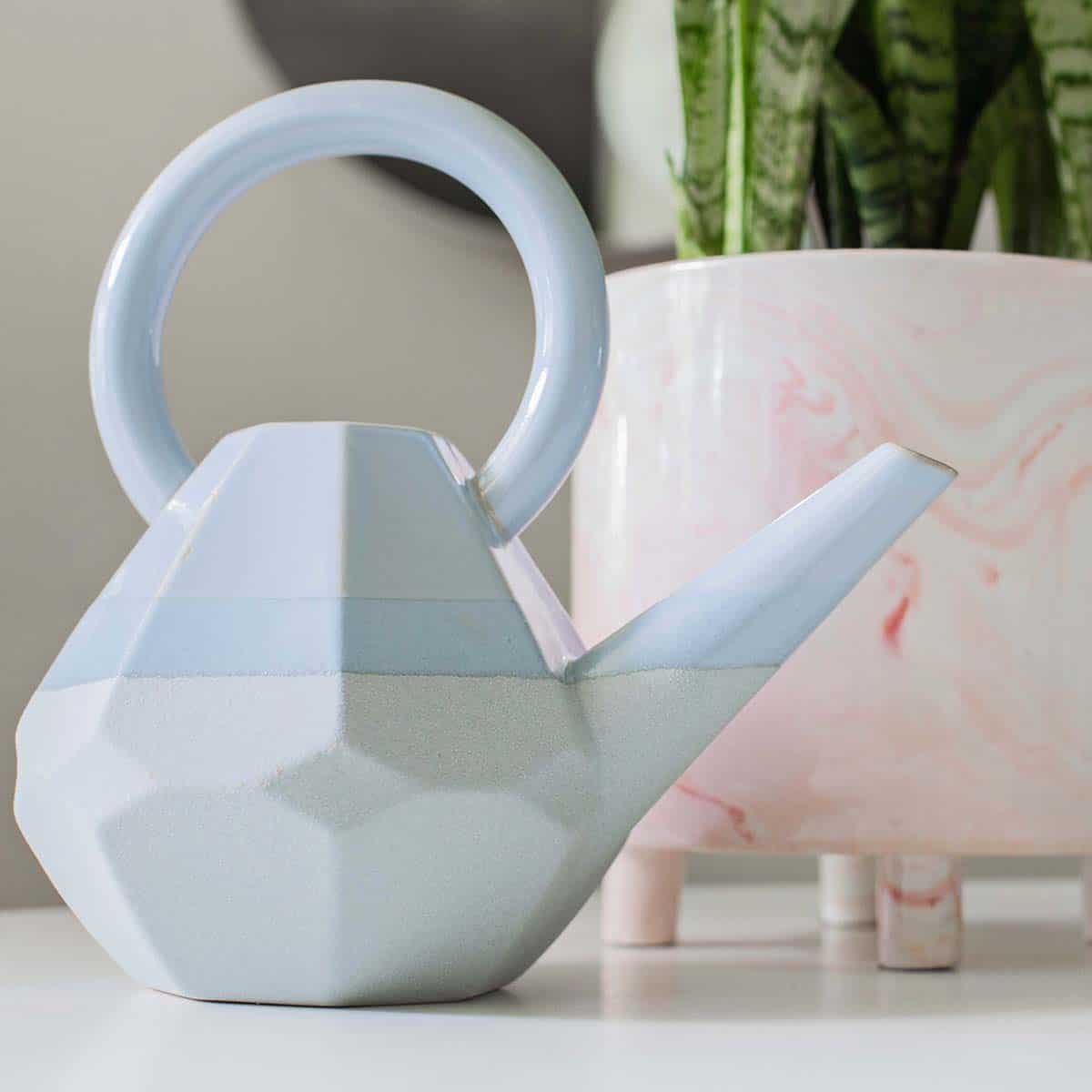
Dusting
Dusting the leaves is a wonderful habit that your sansevieria will thank you for. I grab a slightly damp cloth (not too wet!) and wipe the leaves down on both sides. This will help the sun hit the plant and not block photosynthesis from taking place.
I turn my plant every time I water it. Turning your plant will promote even growth (especially if your plant is near a window). Another tip is to keep your windows nice and clean (on the inside and outside)! This can make a big difference with the amount of light getting to your plant. Squeaky clean windows will let in more light!
Propagating
Propagating a sansevieria is a fun and wonderful process to watch. You can propagate in water or in soil. I personally love propagating in water because you can see the new root growth happening before your eyes.
If you’d like to propagate your sansevieria, simply cut off a leaf using a freshly washed tool. I find scissors are great! You can cut the leaf straight on the bottom or cut a “V” shape on the bottom. This “V” gives your plant more real estate to grow new roots.
Grab a glass vase or jar and stick your newly cut leaf in it. I like to sill my water about 4 inches above the bottom of my freshly cut leaf. Keep your plant in the water and watch little roots start to sprout!
Change the water and rinse the vessel anytime the water gets cloudy. I place my new cutting in front of a window so they can soak up lots of light. When the roots start to grow, you can leave the leaf in the water (I’ve left mine in water for months!) and it will do just fine.
When the roots have sufficient growth (1-2 inches is great), you can pot it in soil! Super easy!
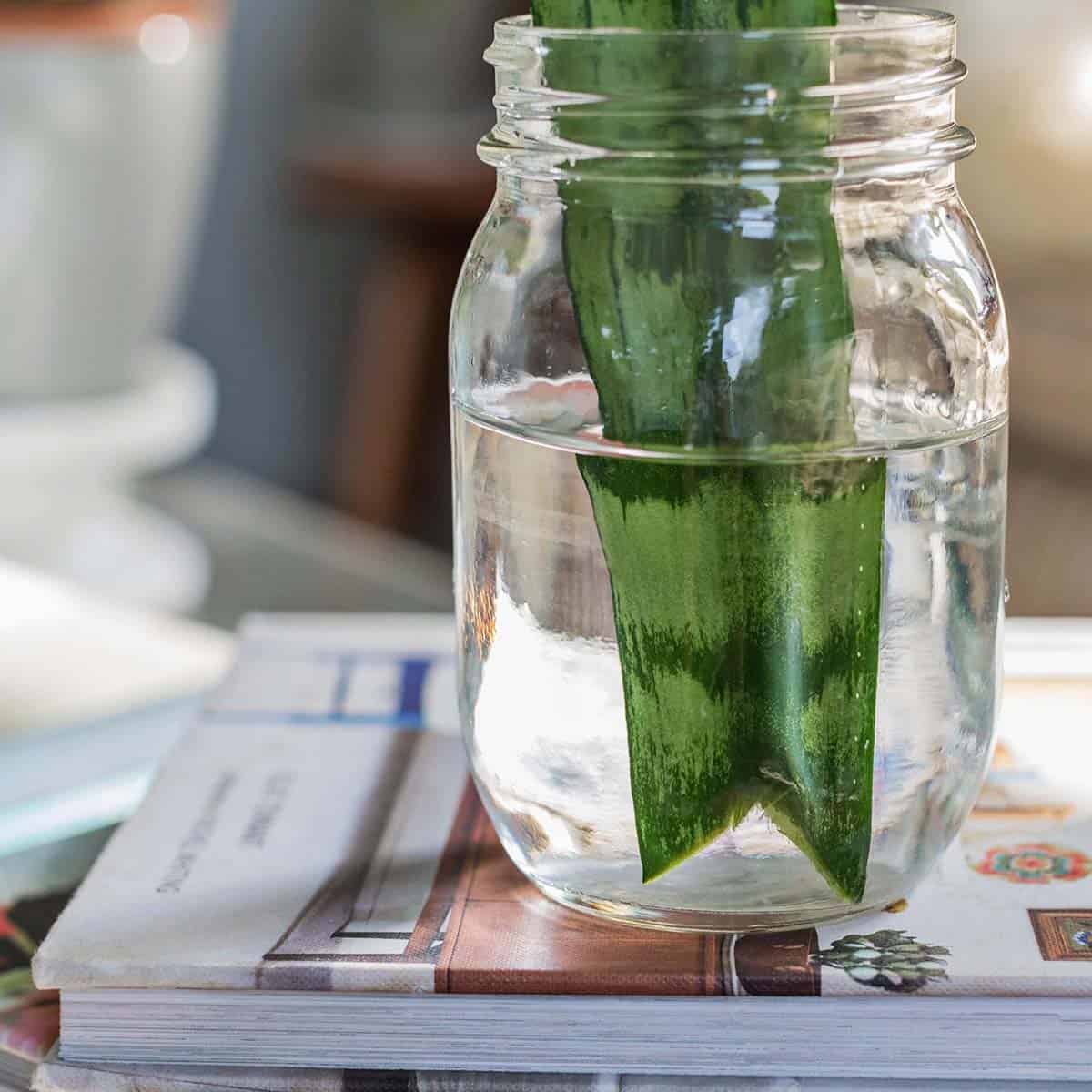
If you want to propagate using the soil method, simply cut your plant (just like mentioned above) and stick your freshly cut plant into a pot with damp soil. As your plant begins to root (you can’t see it happening like the water method), you must make sure the soil doesn’t dry out too much.
As the roots make their way out and grow, they will need constant contact with the soil, so don’t let your plant dry out too much when you are trying to propagate. I’ll check on my freshly propagated leaves and give them more attention than usual.
If the soil has become bone dry, then I will give them a good soak in water. It is very satisfying when your new plant takes root and even begins growing new leaves!
Lastly, one of the best things about sansevieria is the variety of species! This plant has a diverse and beautiful plant family. The classic and most popular plant is the sword-shaped leaf that you see EVERYWHERE (like in this post).
Don’t be afraid to try new species because their care is very similar. Here are two different sansevieria I have in my home. It’s amazing how unique each one is!

Other Species of Snake Plants
This species is called Whale Fin (Dracaena masoniana). It looks like a whale’s fin breaching the water. I love how this plant stands alone. This one leaf is so dramatic and beautiful. Other leaves will eventually grow, but I love the way it looks right now!
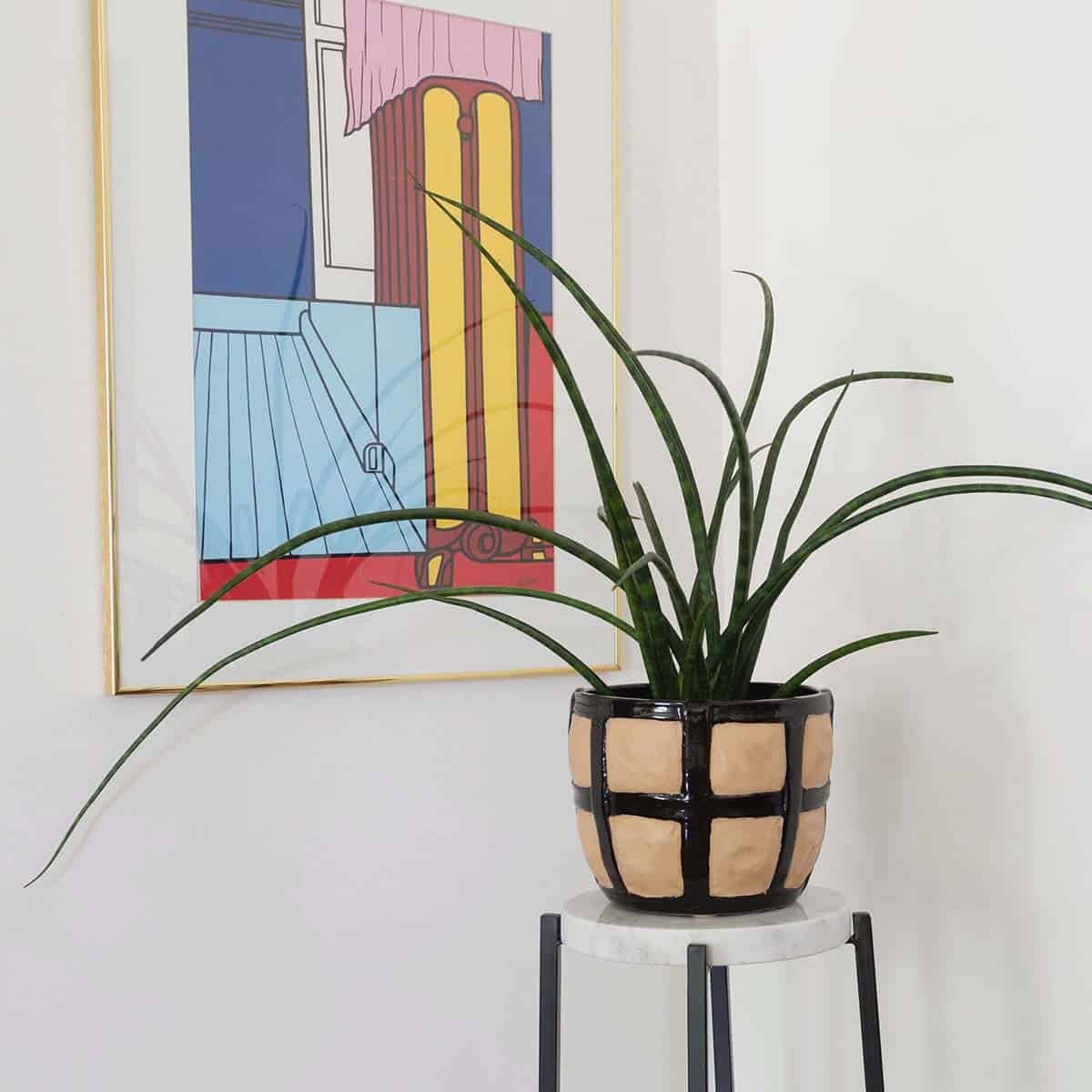
This species is called the The African Spear plant or Cylindrical Snake plant (Dracaena angolensi). It features a barb on the end of it’s more tubular shape and its leaves fan out and become quite large. I’ve had to separate this plant three times just because it grows so quickly! The Dracaena pearsonii variety is similar although that variety has succulent red-tinted leaves.
There is also the cultivar Twist variety (Sansevieria trifasciata) which features twisted leaves, and Rhino Grass (Sansevieria desertii) which are plumper leaves that look resemble rhino horns.
Another intriguing variety is the white-tinged snake plant Bantel’s Sensation (Sansevieria trifasciata) which boasts white vertical stripes up its leaves. The Moonglow (Dracaena trifasciata) variety has a light green color with a silvery hue (and no stripes) that’s very different for a plant-lover who wants a unique color.
Troubleshooting
Yellow or brown leaves: Leaves that are turning brown or yellow usually indicate either overwatering, pests, or root rot. Try watering less, treat the pests, and repot your plant to a slightly larger container if you can see that the roots are becoming too crowded.
Pests: Spider mites, mealybugs, and thrips can be eliminated with neem oil and insecticidal soaps. Try rubbing alcohol for tackle scale insects and mealybugs.
Enjoy your journey with snake plants! -Janae

We recently inherited this plant from our mother-in-law. We’ve owned it for seven months. It does look crowded in the planter, and i’ve been under watering it for fear of yellow leaves. However, some of the leaves on the outside of the plant are turning inside out and beginning to droop. Open to input. It is getting sufficient light as it’s in the corner of our kitchen with indirect light/diffused.
My snake plant needs a little love, so this was perfect timing!
Hello! I want to thank you very much for the wonderful, very detailed information you’ve given to us. I loved reading it. THANK YOU!
I’m going to try propogating mine with these tips, thank you!
I started my snake plant from a cutting in 1970! It has survived much neglect and still looks dramatic. This article reminds me it needs a new pot. Thanks!
Great introduction
My snake plant droops it’s leaves & are very thin. How can I fix this.
Try putting it outside during the warm months and water it when the soil feels dry.
My snake plant droops bit time. In a 12″ pot maybe only three leaves(?) stand straight up; the rest flop down. How can I get all of it to stand straight?
My snake plant is two years old but not growing tall. Does that mean I have a different variety of snake plant or am I doing something wrong?
I’ve never had a snake plant before. They sound very interesting.
I received a plant that is potted to look like a heart. Do I cut the heart so there are now 4 branches or leave it to continue growing like a heart?
I have a snake plant, but it’s drying and turning brown. I was told to put some Coca Cola, is this true?
It was wonderful experience with you through life of this beautiful plant and I got so much information know I feel good thanks for letting me know all about this beautiful plant thanks
Thank you for so much information. I didn’t know I could propagate leaves in water! Wish you had a picture showing the sprouted roots in the water.
I was looking for direction on removing the rosettes to repot those.
Mine is still in the plastic pot and glad to know adding the 2″ diameter for growth when I repot it.
O
Love my snake plant I never know if its in the right pot for its size
This species is called Whale Fin. It looks like a whale’s fin breaching the water. I love how this plant stands alone. This one leaf is so dramatic and beautiful.Glaima
So many helpful tips!